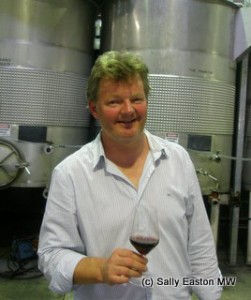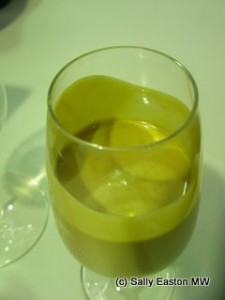An accidental treatise on lees work with chardonnay

Michael Glover
A logistical misadventure meant Michael Glover, the winemaker at Bannockburn Vineyards in Geelong, Victoria had to leave one of his chardonnays on its lees for three years rather than the usual two. It turned out to be an excellent decision.
Since his arrival at Bannockburn seven years ago, Glover has been experimenting to find the vineyards’ best expressions from the 30 hectare estate. For 2006 and 2007, the estate chardonnay had no added acidity, it had no malolactic fermentation. Then, he said “the idea was that malo does good things with texture, so I put texture and richness with time on the lees. You also get a wonderful natural stability.”
Glover is exploring his theory of where site expression comes into a wine. He said his theory is “that varietal character can dominate soil and site character. If we pick earlier, we’re turning down varietal character, and giving site a chance to show itself … if we obey the rules of low yield etc.”
But one of the problems of picking too early is varietal character errs to the anorectic. Now, he said “malolactic comes in to flesh out” the wine, as does time on lees. “Lees does wonderful things” Glover said, “but it’s been ignored because it only happens with time.” Time is costly, so it is one of the “cost-centres” of winemaking that is readily removed from more price sensitive wines the world over. But with time on lees everything becomes more stable, so, among other things, it may well negate the need for mechanical clarification.
It takes quite a bit of time. Glover said “all the exciting things start at about 18 months on the lees. When you start to taste the lees, the goodies are starting to come back 18 months, going on two years.” Such things as weight, dimension, texture, richness and freshness which fill out the mid-palate, plus sweet-pastry notes which are also present on sparkling Blanc de Blancs that have had many years on tirage lees. Overt primary fruit move a bit to the background, with nutty and mealy notes edging forwards.

Chardonnay 'mother' lees
Glover hasn’t thrown out his chardonnay lees for five years. “It’s like a yeast mother” he said. And because he hasn’t thrown away these lees, he was able to add some back to his chardonnay that then had that extra year of maturing on them.
He warns to take care with the technique. He said it’s like “bullets in a gun, you don’t want to use up your bullets. With lees stirring, I stir just a couple of times a year. That way the wines don’t look leesy, but they are lees-driven.”
It was the 2008 estate chardonnay that benefited from three years, rather than two years, on lees. It is due to be released in the middle of 2012. And, said Glover, “because it worked, SRH will now always be on lees for three years.” The 2009 estate chardonnay reverts to two years on lees. SRH is the property’s top chardonnay, named after Stuart Reginald Hooper, who founded Bannockburn in 1972 and comes from a single vineyard on Olive Tree Hill, which Glover said provides the clearest tight and powerful expression of Bannockburn’s marine sediments.
The first SRH vintage with three years’ lees ageing is the 2009.
Tasting notes, in situ, February 2012.
Bannockburn Vineyards, Chardonnay 2008, Geelong, Victoria
Three years on lees. The one-off.
Cream, sweet prickly spice thing. Sweet-lees concentration and texture. Demands being held in the mouth to allow complex flavours emerge. Has both freshness and weight flowing together, and length of palate and finish is extraordinary.
Bannockburn Vineyards, Chardonnay 2009, Geelong, Victoria
Creamy nose with steely, magnolia notes at the mid-palate. A gentle lemon toastiness, and rich leesy, cream-cheese texture with a little jig on the tongue. This has power, intensity and concentration. Lovely wine.
Bannockburn Vineyards, Chardonnay 2010, Geelong, Victoria
Bottled a week before the tasting. Golden tints, creamy-lemon-syllabub type thing on nose, followed up by sweet palate attack, rich, textured and sweet-savoury. Clearly embryonic.
Bannockburn Vineyards, SRH 2008, Geelong, Victoria
In barrique for two years. one-third malo. To be released in June 2012.
The merest reminders of toasty new oak on first nose, and not on the palate at all. Flavours of sweet tropical fruits with crisp lemon freshness. Medium weight with wonderful lift, and a vibrant, lively tingle through the palate. Long finish. This is lovely.
Bannockburn Vineyards, SRH 2009, Geelong, Victoria
Tasted after it had been bottled for just a week. Not yet released
Sweet and spiced note of long lees ageing. Rich and fresh, warm and rounded mid palate, with a sweet-steel combo of huge concentration. Vg.
My visit to Australia in February 2012 was sponsored by Wine Australia.



